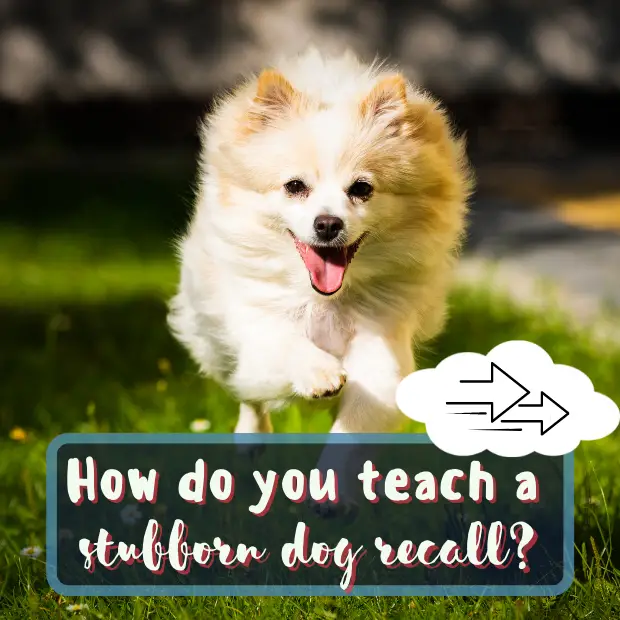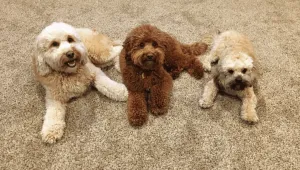I think we can all attest to the fact that dogs are, well…dogs. And as such, they have their own (personality) quirks. Some dogs may be more difficult to train than others. So how do you teach a stubborn dog recall? Check out these tips!
Table of Contents
ToggleContents of this article:
- Teaching recall to a stubborn dog.
- Why doesn’t my dog come when called?
- Summary – How do you teach a stubborn dog recall?
Teaching recall to a stubborn dog.
I’m often asked “How do you teach a stubborn dog recall?”
Stubbornness is a human trait, and fortunately not a canine one. A dog that does not come when called is not being stubborn; he’s just being a dog. If you want your dog to come when called, here’s how to train him and make it worth his while.
Why doesn’t my dog come when called?
Dogs refuse to do things for two reasons: either they don’t understand what’s being asked of them or they’re not sufficiently motivated at that time.
There’s not a dog in the world that is going to think “I want what you’ve got and I know what you’re asking but I’m just not going to do it. ” Dogs are smart but they’re not quite capable of that.
Let’s explore each of these possibilities in turn, in order to find out what’s going wrong and resolve the problem.
The dog doesn’t understand.
Firstly, your dog may not be complying because they don’t understand what you’re asking in this instance. Dogs do not generalise very well.
An example of this is when I tell my puppy class participants we’re going to be working on sits and downs. There will always be at least one person who tells me that their dog knows how to sit already.
But when they attempt to demonstrate and say “Sit”, the dog just looks at them as if to say “Nope. Never heard that cue before in my life!”
Why does this happen? It’s because they have taught their dog to sit in the kitchen at home, with the dog facing them and the human standing up holding a pot of food. When you change something about that picture, the behavior can fall apart because the dog has only learnt the cue in that particular context.
So as soon as the human isn’t facing the same way, or if they don’t have the pot of food, or if their body position has changed from standing to sitting, or the location has changed, the dog doesn’t understand what’s being asked of them in this context.
The solution to this is to practice your dog’s cues in lots of different locations.
When you’re trying a behavior for the first time in a new environment, you may have to go back a few steps to help your dog understand and use high-value rewards to hold their attention.
The dog isn’t sufficiently motivated.
The second reason your dog might not recall is because they’re not sufficiently motivated. This usually comes down to the fact that the person has not trained their dog in a way that makes recalling fun, or they have not made it more rewarding than whatever else the dog is choosing to do instead.
If you want your recall to be strong, you need to put in the effort to make it the most fun and rewarding thing your dog can do.
Start by teaching your dog to love coming when called in your house or yard with no distractions. Make it a game by calling them and running away, encouraging them to chase you. When they catch up to you, give them a big party – lots of treats, petting, and excited voice.
Once your dog is really enthusiastic about coming when called in your house or yard, you can start adding in distractions a little at a time. Begin with things that are not too exciting, like someone walking by outside or the family cat walking by.
As your dog becomes more reliable, you can gradually make the distractions more exciting, like another dog walking by or a car driving by. If at any point your dog does not come when called, go back to a previous level of distraction and work up from there again.
If you have been consistent with your training and your dog is still not recalling, there are a few other things you can try. First, check that you are using a high-value reward that your dog really loves. If they are food motivated, use small bits of hot dog or chicken.
If they love toys, use a toy that they don’t get to play with very often as a reward. You can also try using a combination of rewards – for example, giving a treat when they get to you and then playing with their favorite toy once they are sitting in front of you.
Go right back to basics and make sure you are only asking your dog to come to you when you are sure they will be successful. If they are not recalling consistently at a close distance, do not ask them to come to you from across the park.
Remember that recalls are built up over time – start with easy recalls and work up to harder ones as your dog becomes more reliable.
Summary – How do you teach a stubborn dog recall?
If you are having trouble teaching recall to a stubborn dog, try the above tactics. With consistency and patience, you will be able to teach your dog recall.
For more info on nailing your dog’s recall click here.







